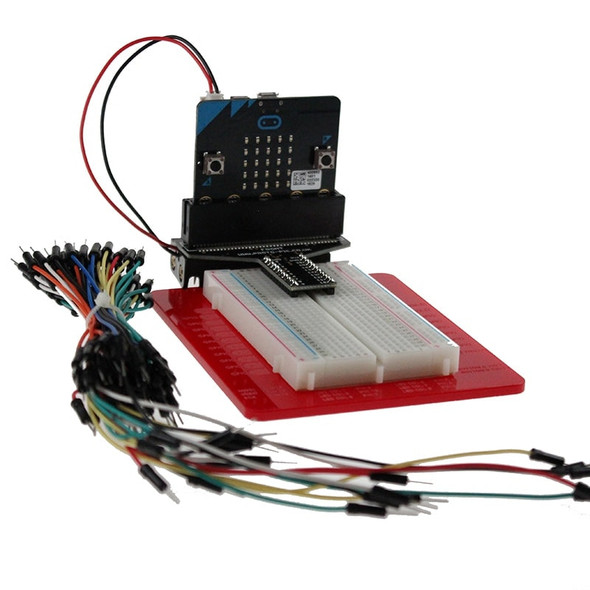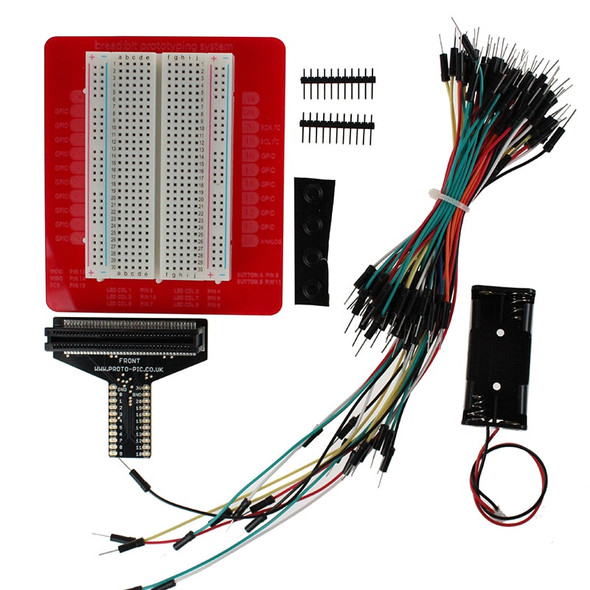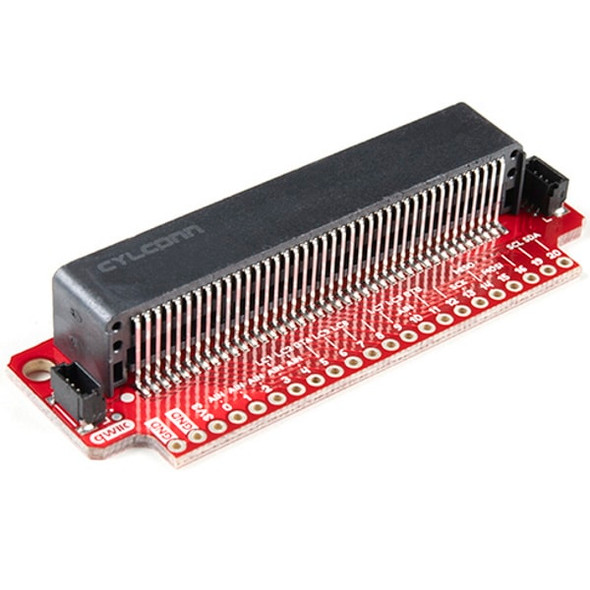Description
exhi:bit Prototyping system for micro:bit
Although the micro:bit is a wonderful platform, the classroom management and
the workshop management of all the supporting accessories is a challenge.
That's why we created the exhi:bit - a prototyping and development system for the BBC micro:bit.
We wanted to create a system where a student could go from a prototype board to a finished, more permanent project seamlessly.
But importantly, we wanted to create a system where the main workhorse parts could be reused time and time again.
| Exhi:bit has an edge connector socket which the micro:bit plugs into. As soon as the micro:bit is plugged in, you are ready to start creating. |
| Exhi:bit has all the micro:bit pins broken out to header connectors, for connection to plugin exhi:bit daughter boards and plugin classroom project boards, but also to generous pads on the edge of the board - so you can connect to your project with conductive thread, banana jacks or crocodile clips. |
| A generous prototyping area is provided for users who wish to create permanent projects, directly onto the exhi:bit or you can use a DIY Daughter board to easily swap projects |
|
Or.. simply add a half size breadboard (not included) to prototype your circuit. |
| All of the circuits you create on your exhi:bit can be powered by using a 5-9V DC power supply (not included) or the micro USB port. The micro USB port isn't intended for programming the micro:bit - we just provided it as a convenient way to power the board. The on-board regulator ensures the voltage is micro:bit friendly. We've now added a raw pin so you can tap the RAW voltage for your devices. |
| How many times have you opened your drawer to find a board and had no idea what it was for? Three areas on the exhi:bit are provided for taking notes using a sharpie marker or similar, so you can keep track of which project is on which board - or which student has created the project. |
| A range of classroom project plug in modules for the exhi:bit will be released soon. |
This is the second revision of the exhi:bit, we've removed entirely the acrylic plates and stand offs and instead included 4 rubber feet. We now no longer include the breadboard as many people had requested this in order to lower the cost as they already owned a breadboard. We’ve also added a raw pad to the board so you can power a device directly from the input before it goes through the regulator circuit.
CAD Resources:
- exhi:bit prototyping system Step file. Right click & save as
5 Reviews
-
Title of review 30100
This is a must-have MB accessory! Makes life alot easier when pushing the MB to new places
-
Title of review 809
Generally a well constructed board, let down by the fact that they put the breadboard at an angle on its plastic carrier. Would it be too much trouble to have a jig to ensure this is placed square? Every time I look at it the misalignment disturbs me. Other than that, it could merit 5 stars.
-
Title of review 808
really helps with doing anything useful with the microbit, allows you to create complex circuits without all the faffing about
-
Title of review 807
I recently ordered the exhi:bit Prototyping System from Proto-Pic having previously seen a video demonstration of it on their website. It looked to be very well designed and it seemed particularly suited for the Education market, I intend personally to use it with my two grandsons who are in their primary years. When it arrived in the post, promptly as always from Proto-Pic, it was clear that a tremendous amount of thought had gone into designing this system. The perfect size of the base board has allowed the ideal amount of space for every terminal to be well separated and clearly labelled for its end users. It also includes a further panel at the bottom end which lists the terminals along with the lines and components to which they are connected on the BBC micro:bit. This makes it unnecessary to require a drawing of these connections to be at hand. Like the five larger terminals on the micro:bit, which are actually slightly larger on the exhi:bit, they enable connections to be made using crocodile clips or 4mm banana plugs to all of the lines on the micro:bit, including three each of the 3 volt and Ground lines.<br /><br />I have personally handled and designed many printed circuit boards over four decades and I must say that the finished quality of the exhi:bit board equals the best I have seen. It is protected with a nicely shaped, clear acrylic sheet which also strengthens the PCB so that it will be robust in use. It is accompanied by a half-size plug-in breadboard which itself is mounted on a sheet of acrylic and fits very neatly onto the master board when in use. I tried out various circuits on this system with a micro:bit attached securely at the top end, running both Python and Block Editor programs to test it all out. Everything I tried worked exactly as I expected.<br /><br />In addition to being powered by the micro:bit via its Micro USB connector there are two other ways in which the prototyping system can be powered. There is a standard 5mm DC connector which can run off a battery pack or Mains DC plug pack of 5 to 9 volts and also a further Micro USB socket with only its 5 volt and Ground lines in use, both of which I have tried. These connectors lead to an on-board DC voltage regulator to bring the supply down to 3 volts for safely connecting external components to the micro:bit via two each of 3 volt and ground pins conveniently placed adjacent to the top end of the breadboard. When using these external DC connectors the exhi:bit has a very useful on/off switch on the right hand side with an on-board micro LED to indicate when the external power is switched on. This LED is also illuminated when power is supplied to the BBC micro:bit via its USB lead connected to a computer.<br /><br />It is clear that I am going to have a lot of fun experimenting utilizing the Proto-Pic exhi:bit both with my grandsons and on my own! Keep up the good work Proto-Pic!
-
Title of review 806
This has clearly been a well thought out product which enables you to easily design external control circuits for the micro:bit. delivery was super quick too
















